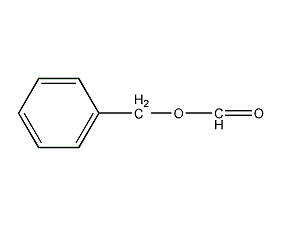
Structural formula
| Business number | 02QA |
|---|---|
| Molecular formula | C8H8O2 |
| Molecular weight | 136.15 |
| label |
Benzyl formate, Benzyl formate, Formic acid benzyl ester, Benzyl alcohol formate, Benzyl methanoate, spices |
Numbering system
CAS number:104-57-4
MDL number:MFCD00014128
EINECS number:203-214-4
RTECS number:LQ5400000
BRN number:2041319
PubChem ID:None
Physical property data
1. Characteristics: It has a strong floral aroma, a jasmine-like aroma, a fruity and spicy aroma, and a blackberry-like aroma.
2. Density (g/mL, 25℃): 1.0881
3. Relative vapor density (g/mL, air=1): 4.7
4. Melting point (ºC): 3.6
5. Boiling point (ºC, normal pressure): 203
6. Relative density (20℃, 4℃): 1.0814
7. Refractive index (25ºC): 1.5153
8. Flash point (ºC): 83
9. Refractive index at room temperature (n20 ): 1.5143
10. Autoignition point or ignition temperature (ºC): Undetermined
11. Vapor pressure (mmHg, 25ºC): Undetermined
12. Saturated vapor pressure (kPa, 84ºC): 1.33
13. Heat of combustion (KJ/mol): Undetermined
14. Critical temperature (ºC): Undetermined
p>
15. Critical pressure (KPa): Undetermined
16. Log value of oil-water (octanol/water) partition coefficient: Undetermined
17. Explosion upper limit (%, V/V): Undetermined
18. Lower explosion limit (%, V/V): Undetermined
19. Solubility: Insoluble in water, miscible In alcohols, ketones, aromatic hydrocarbons and halogenated hydrocarbons.
Toxicological data
1. Acute toxicity: Rat oral LD50: 1400mg/kg; Rabbit skin contact LD50: 2mg/kg; 2. Mutagenicity: DNA repair test: Bacillus subtilis, 22mg/disc; 3. Can enter through the respiratory tract and digestive tract In the body, it has a stimulating effect on the skin and mucous membranes.
Ecological data
This substance is slightly hazardous to water.
Molecular structure data
1. Molar refractive index: 37.73
2. Molar volume (cm3/mol): 125.9
3. Isotonic specific volume (90.2K ): 312.4
4. Surface tension (dyne/cm): 37.8
5. Dielectric constant:
6. Dipole.� (10-24cm3):
7. Polarizability: 14.95
Compute chemical data
1. Hydrophobic parameter calculation reference value (XlogP): 1.6
2. Number of hydrogen bond donors: 0
3. Number of hydrogen bond acceptors: 2
4. Number of rotatable chemical bonds: 3
5. Number of tautomers:
6. Topological molecular polar surface area (TPSA): 26.3
7. Number of heavy atoms: 10
8. Surface charge: 0
9. Complexity: 95.4
10. Number of isotope atoms: 0
11. Determine the number of atomic stereocenters: 0
12. Uncertain number of atomic stereocenters: 0
13. Determine the number of chemical bond stereocenters Number: 0
14. Number of uncertain chemical bond stereocenters: 0
15. Number of covalent bond units: 1
Properties and stability
1. Avoid contact with strong oxidants, strong acids, and strong alkali. It is extremely flammable and should be treated as flammable materials. Can react strongly with oxidants.
2. Found in flue-cured tobacco leaves and burley tobacco leaves.
3. Naturally found in rose oil.
Storage method
Store in a cool, ventilated warehouse. Keep away from fire and heat sources. The storage temperature should not exceed 30℃. They should be stored separately from oxidants, acids, alkalis, and food chemicals, and avoid mixed storage. Use explosion-proof lighting and ventilation facilities. It is prohibited to use mechanical equipment and tools that are prone to sparks. The storage area should be equipped with emergency release equipment and suitable containment materials.
Synthesis method
1. Obtained from the reaction of benzyl chloride and formic acid. Place benzyl chloride, excess sodium formate and formic acid in a sealed container and react at 140°C for 2 hours. Or add anhydrous acetic acid to anhydrous formic acid under cooling, preheat the mixture to 50°C, slowly add benzyl alcohol, maintain the reaction at 50°C, then add water to wash, dry, and fractionate to obtain the finished product.
2. Tobacco: BU, 56; FC, 18; FC, 40.
Purpose
Soluble industrial solvent, used as solvent for nitrocellulose, cellulose acetate, stearic acid, quick glue paint, etc. For spices, it can be used to prepare various flavors, such as jasmine, orange blossom, moonflower, hyacinth, dianthus and other flower essential oils; it is also used to prepare apricot, peach, banana, plum, pineapple and other edible flavors.

 微信扫一扫打赏
微信扫一扫打赏

